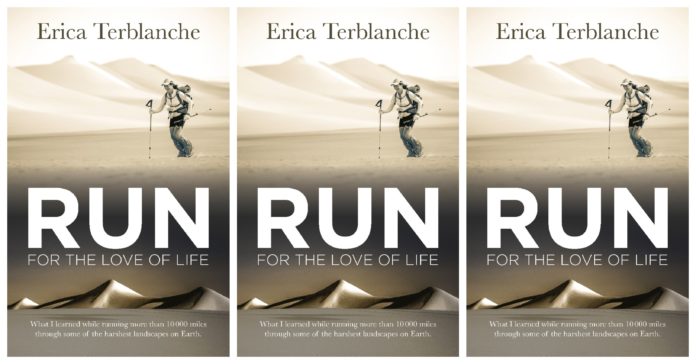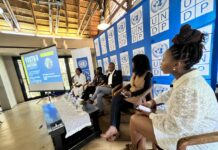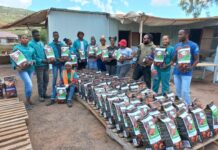RUN for the Love of Life is a thought-provoking memoir that gently guides the reader through the author’s rawest and most central moments of her life. Together, one begins to understand what she has gained, even during those most challenging of times, and by proxy how each of us can triumph over the difficulties in our lives. Erica Terblanche is an accomplished endurance runner and adventure racer, and has won numerous iconic long-distance races all over the world. RUN for the Love of Life is her first book.
An extract from the book has been republished below with permission.
Day 5 – Rest
The Long Day was over. At 8am, the last racers finally crossed the line after 26 hours of battle. Lorraine collapsed next to me, her feet looking like those of a leper: Bandaged, bloodied, and swollen beyond recognition. She fell into the deepest, sweetest sleep for the remainder of the day.
We had a whole day to rest, swim, eat and recover before we had to face the final 73km to the finish. All day we lazed together under the hot marquees, talking nonsense, telling stories and sharing our meagre rations of food as acts of great generosity. On these races, by the fifth day, food is bitterly scarce.
Ayob brought me a rusk – a hard biscotti-like, quintessentially South African biscuit made for dunking. I shared it with Helen. Richard gave me a few sticks of sugared, dried fruit. We call it mebos. It was a lifesaver when my stomach refused everything else. Morgan arrived with gifts of delicious oatmeal bars, which saved me from having to gag on oats for breakfast. Hong Tan from Singapore gave me two rice cakes. They must have been the most delicious things I had eaten all race – bland, light and forgiving on my stomach.
A desert race is made up of the sum of a thousand small kindnesses.
Our shared adversity opens us to each other. We share our precious morsels of food; we hobble to the kettles on sore feet to fetch hot water for the fallen; we give away our last pair of socks; we rub each other’s painful shoulders and offer to cuddle up for body heat against the cold desert chill.
Evening cooled the Earth. Fireflies darted back and forth over the swift, black river, and arced lighting silhouetted the distant mountains that we had crossed on the Long Day. The air smelled humid and rich with the promise of approaching rain.
By 10pm, desert rain had arrived on the tail of a dusty storm. The tents flapped dangerously, and after a volley of fierce gusts, three of them collapsed on to sleeping racers. In the dark, we scurried to help each other and settled back down for a restless, watchful sleep. I lay awake for a long time, smelling the wet Earth and trying to ignore my nausea and bowel discomfort, which had returned in full force.
Day 6 – Coming home
50km
We were slow to the startline at on the Day 6, somehow lethargic from the rest. Ahead of us loomed another 50km of endurance, to be toploaded on to bodies that had already covered 180km of racing through a hell of sand, heat and pain.
About 23% of the field had already withdrawn. It was the highest number of withdrawals recorded in the 20-year history of KAEM. Alet had reported a record number of critical medical emergencies and had administered a greater number of saline drips than on any previous event.
At 8:30am, I set off together with Helen, Russell and Hylton. We ran hard out of camp and across the deep sand, with Helen chomping at the bit and pushing the pace. Having neither the energy nor the mind to chase, I let them go.
To my surprise, I arrived at Checkpoint 1 just as Helen left. Around 20km, shortly after Checkpoint 2, I caught up with her again. She was walking.
“Are you okay?” I asked and slowed down to walk with her. The feeling between us was pleasant and collegial. “Yes,” she answered curtly – not because she was unfriendly but because she spoke little. Her candid brevity was most appealing. On the flats and hard-packed sections, we jogged together, and in between the long silences, Helen told me about her stellar career in triathlons, and how, in 2010, she had become one of the top 10 Ironwomen in the world. She had taken the podium together with triathlon greats like Chrissie Wellington. I understood that she had come to the desert to rest from the chase and the pressures of the leader board, as well as some other heartaches in her life. In some way, we all went to the desert to heal.
We trotted side by side, enjoying each other’s company, and entered into Checkpoint 3 where the volunteers welcomed us: “Looks like the two of you are on an easy training run.” Helen sat down. As always, I refrained from taking a seat. In long-distance racing, nowhere poses greater danger than checkpoints, where there is shade and the temptation of chairs and the beguiling care of volunteers. The moment one sits down, four minutes can flash by in a wink. On a stage with five checkpoints, that amounts to 20 minutes foregone! Good transition discipline can secure a win against far stronger competitors.
My strategy in every race is to remove the lid of my hand-held bottle well before I get to the checkpoint, then immediately on arrival, fill it, while gorging on as much water as my stomach can onboard. I try to do this pretty much without breaking my stride. I then pour some water over my head and neck and immediately head out while thanking the bighearted volunteers. This process burns less than 25–30 seconds.
As I left the checkpoint, I offered: “I will trot slowly. Catch me.” Helen never caught me again. I believe it was on purpose. Multi-day desert racing is so much more than just a duel to the finish, it is a pilgrimage of the heart. Compared to other sports, like triathlons and tennis and golf, it is a small and obscure sport, and it is for many of us more than just a public stage for athletic performance. A desert race is a place of making deep connections along the way and of learning about oneself at the edge of endurance. It is a place of becoming so quiet within that one gets perspective on one’s life and what needs to be done. Sometimes, the quietness inside is so spacious that one gets a glimpse of a memory of ancient times, and of ways we used to be and how we used to live in the beginning.
When I run in the Kalahari and imbibe on litres of water at the checkpoints, it feels oddly familiar, like some primordial ways are coming back to me. Sometimes I collect a long stick from the veld and run, carrying it like a spear in my right hand. Maybe my body knows this stance from what feels like a long time ago. It is the stance of the Bushman hunter on the run. Bushmen were accustomed to the natural cycles of famine and feast. They had the ability to consume vast amounts of food and water, and their stomachs were even able to stretch sideways to accommodate this eating cycle. As with water, so it was with the hunt.
Deep in my heart I feel like a /Gwikwe64. I love running at midday when the sun is at its zenith. Who knows? Perhaps some old part of me remembers that this is the best time of day to hunt. I eat sparsely throughout the day, and at night, I can put away a meal that would put a competitive eating champion to shame. I have eaten like this for most of my racing life, long before intermittent fasting became a thing. It is the way of the hunting Bushman clan. With every day we stayed in the Kalahari, my body and my soul felt more and more at home.
Helen arrived in camp 30 minutes after me. She held aloft one shoe: “I shouldn’t have changed my socks. My feet are killing me. Not a good day.”
For all intents and purposes, Helen had won KAEM, because ahead of us lay the final stage of only 23km to the finish line. It was far too short a distance for me to erase the one-hour gap that remained between us. It did not matter. Helen was a worthy champion and I felt proud that I had not failed myself and given up on the second day when I lost the race in Death Valley.
What matters, in racing, as in life, and as in love, is that we accept that sometimes the path will be hard. What matters in the end, whether it is going our way or not, is whether we are able to remain committed. It is only by staying in that we can build something meaningful in life. It is only by persevering across the rocky path that we can grow and become better. Such is the worthwhile journey. One will never reach the highest bar in a spirit of ambivalence or half-heartedness.
Helen came to rest next to me. We sat under the hot canvas and shared a portion of my goji berries while enjoying the animated banter around us. The atmosphere in camp was jovial, for the worst was behind us. There was also a palpable sadness because we knew it would soon be over.
We sat together in little clumps, laughing and chatting, wishing to somehow draw out the hour and hold on to the beauty and simplicity of the experience; to take home with us those feelings of community, belonging and camaraderie, and to hold on to the friendships that had been formed in special moments on that great sand face of the Kalahari. And above all, we wanted to hold on to that feeling of belonging in the wild.
Irish Fergus asked me at the beginning of the race: “Are you a writer who runs or a runner who writes?” If I had had the presence of mind then, I would have said that I am a modern-day Pied Piper who writes to remind our civilisation about the necessity of remaining connected to Nature, of living simply, and of having a deep reverence and relationship with the life in all things.
I would say to Fergus that, like him, I have retained something of the Kalahari Bushman spirit, and that I have come to tell our children, and their children, a story of a far-off place where a human and a gemsbok can still have a decent conversation.
Run for the Love of Life is available online and at all good bookstores.
RELATED:
Loss and food in “Crying in H Mart” and “Brown Baby”









